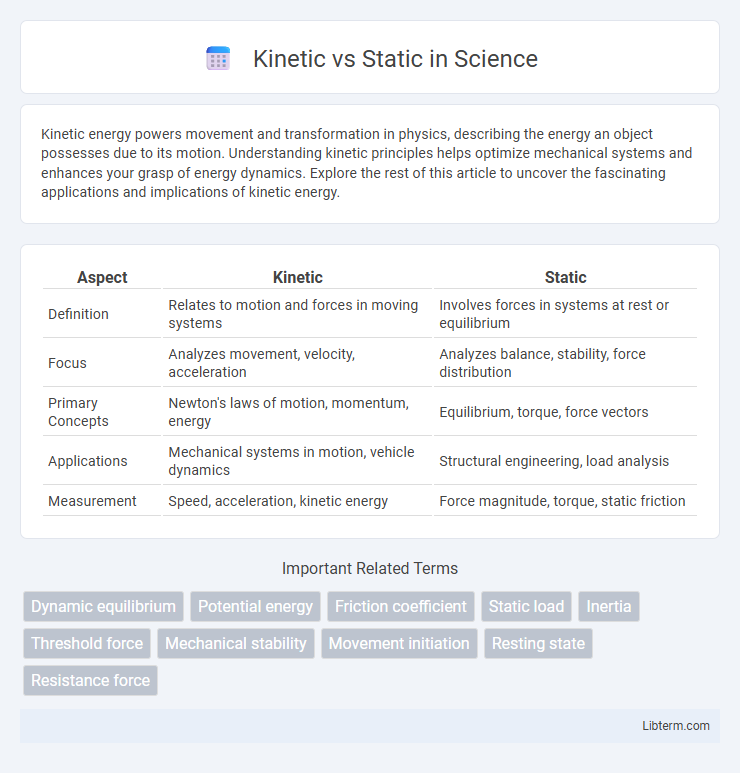Kinetic energy powers movement and transformation in physics, describing the energy an object possesses due to its motion. Understanding kinetic principles helps optimize mechanical systems and enhances your grasp of energy dynamics. Explore the rest of this article to uncover the fascinating applications and implications of kinetic energy.
Table of Comparison
| Aspect | Kinetic | Static |
|---|---|---|
| Definition | Relates to motion and forces in moving systems | Involves forces in systems at rest or equilibrium |
| Focus | Analyzes movement, velocity, acceleration | Analyzes balance, stability, force distribution |
| Primary Concepts | Newton's laws of motion, momentum, energy | Equilibrium, torque, force vectors |
| Applications | Mechanical systems in motion, vehicle dynamics | Structural engineering, load analysis |
| Measurement | Speed, acceleration, kinetic energy | Force magnitude, torque, static friction |
Introduction to Kinetic and Static Concepts
Kinetic concepts involve the study of forces and motion in objects that are moving, emphasizing dynamics and the effects of energy transfer. Static concepts focus on analyzing forces in objects at rest or in a state of equilibrium, highlighting balance and structural stability. Understanding both kinetic and static principles is essential in fields such as physics, engineering, and mechanics for solving real-world problems related to motion and stability.
Defining Kinetic: Motion in Focus
Kinetic energy refers to the energy possessed by an object due to its motion, quantified as half the mass multiplied by the velocity squared (KE = 1/2mv2). It plays a critical role in mechanics, influencing how forces interact with moving bodies and affecting their momentum and work potential. Understanding kinetic energy is essential for analyzing dynamic systems ranging from simple machines to complex physical phenomena.
Understanding Static: The State of Rest
Static refers to the state of rest where objects remain stationary without any movement or change in position over time. In physics, understanding static equilibrium involves analyzing forces balanced in such a way that there is no net force or acceleration acting on the object. Static friction plays a crucial role in maintaining this state by preventing motion until an external force exceeds its threshold.
Core Differences: Kinetic vs Static
Kinetic energy involves motion, representing the energy an object possesses due to its movement, while static energy refers to stored or potential energy, existing without movement. The core difference lies in kinetic energy being dependent on velocity and mass, expressed as 1/2 mv2, whereas static energy is related to position or configuration, such as potential energy in a stretched spring or elevated object. Understanding these fundamental distinctions is crucial in physics, engineering, and biomechanics for analyzing dynamic versus stationary systems.
Real-World Applications of Kinetic Principles
Kinetic principles govern the motion of objects and have critical real-world applications in fields like biomechanics, automotive engineering, and sports science. Understanding kinetic energy and forces enables engineers to design safer vehicles by optimizing crash impact absorption and improving fuel efficiency through motion analysis. In sports, kinetic concepts help enhance athletic performance by analyzing movement patterns and energy transfer during physical activities.
Practical Uses of Static Principles
Static principles govern structures and objects at rest, playing a crucial role in engineering and architecture by ensuring stability and load distribution. These principles are essential for designing bridges, buildings, and dams, where forces must be balanced to prevent collapse or deformation. Applications extend to everyday items such as furniture and machinery supports, where static equilibrium guarantees safety and durability.
Kinetic vs Static: Pros and Cons
Kinetic energy involves motion, offering advantages like dynamic strength and improved metabolism, but it carries risks of injury due to impact and fatigue. Static energy emphasizes stability and endurance, promoting muscle control and reduced injury risk, yet it may limit overall cardiovascular benefits and dynamic flexibility. Choosing between kinetic and static approaches depends on fitness goals, balancing the trade-offs between movement intensity and muscular endurance.
Industry Examples: Kinetic vs Static Solutions
Kinetic solutions, such as automated assembly lines in automotive manufacturing, enhance productivity by enabling continuous motion and real-time adaptability, while static solutions like fixed robotic arms suit repetitive, high-precision tasks in electronics production. In the logistics industry, kinetic conveyor systems streamline package sorting processes, contrasting with static shelving that optimizes storage density but limits dynamic handling. Energy sectors employ kinetic wave energy converters to capture ocean power efficiently, whereas static solar panels remain the dominant, stable method for harnessing sunlight.
Safety Considerations: Kinetic and Static Forces
Kinetic forces involve motion, requiring safety measures such as impact resistance and dynamic load management to prevent injuries during movement or sudden stops. Static forces remain constant and demand structural stability and proper load distribution to avoid failures under sustained pressure. Understanding the distinction between kinetic and static forces is critical for designing effective safety protocols in environments prone to both dynamic and static stress.
Conclusion: Choosing Between Kinetic and Static
Choosing between kinetic and static approaches depends on the specific application and desired outcomes. Kinetic methods offer dynamic interaction and adaptability suited for real-time environments, while static approaches provide stability and predictability ideal for controlled settings. Evaluating performance requirements, resource availability, and context ensures the optimal selection between kinetic and static solutions.
Kinetic Infographic

 libterm.com
libterm.com